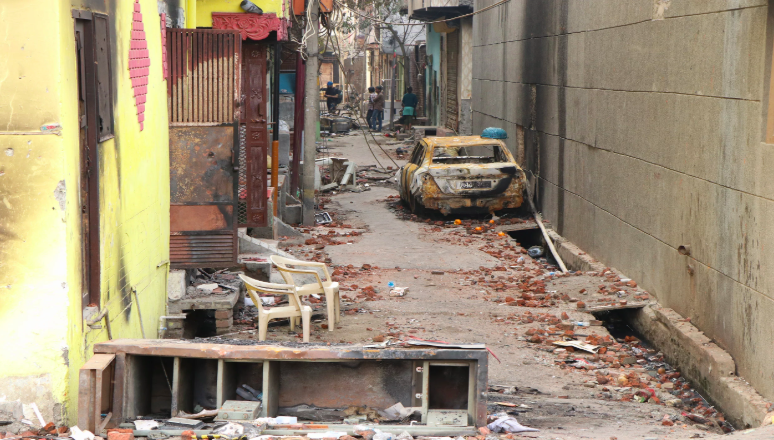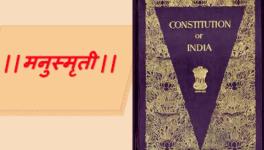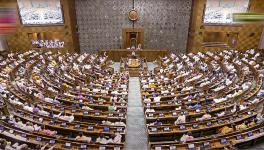Delhi Violence 2020 and Why Non-Hindutva Politics Fails Us

Photo by Kamran Yousuf/NewsClick
Within two weeks of its resounding defeat in elections to the Delhi Assembly in February 2020, Hindutva was in full bloom in several neighbourhoods of North-east Delhi. The area burnt for three days as rampaging mobs targeted houses and shops owned by the Muslim minority and killed with impunity. The state machinery and the government elected with a thumping majority only days ago were conspicuous by their absence. Chief Minister Arvind Kejriwal, who had projected himself as the beloved ‘beta’ (son) of Delhi during the election campaign, tried his best to sleep over the killings. The poor guy ended up making a miserable nobody of himself.
The minimal security of the human self is the primary condition of politics, which separates even the least developed societies from the Hobbesian war of everyone against everyone. Three days of killings in Delhi showed the all-round failure of the Indian polity to provide security to the most vulnerable Indians. It is not just a matter of the success of Hindutva organisations in fanning majoritarian communalism. Failure of the non-Hindutva polity, most clearly exemplified in the deliberate inactivity of the largest political party in the city, namely the Aam Aadmi Party, also needs to be underscored.
Hindutva of course, feeds upon such failure. However, it is surprising how little the ‘why’ of this failure is discussed, both in the popular media and academic analyses. “Soft” Hindutva is a common refrain used at different times for nearly all non-Hindutva political parties. Why non-communal parties choose to remain silent on crimes of majority communalism, or half-drape themselves in Hindu ritualism is little explored.
Two common fallacies bedevil explanations for such decisions. The first is to fall back upon personal choices of the leadership. The second is populism, which assumes that these parties just follow what their voters want. Both fallacies stem from liberalism, which, both in its moral-political and intellectual strands, fetishises humans as free individuals, and fails to take adequate account of the power of social, economic and cultural hierarchies.
An essentialised understanding of humans also fails to grasp internal forces of social change. Decisive shifts in the polity are thought of as stemming only from actions of exceptional individuals or organisations. For example, liberalism is hyperactive in presenting Hitler as the sole cause of the successes and crimes of Nazism in Germany. The latter’s seeds in the authoritarian nationalism and imperialism of Germany, brilliantly analysed by Arthur Rosenberg in Fascism as a Mass Movement, rarely get mentioned in liberal explanations.
Similarly, most analyses of the successes of Hindutva present it as due to the actions of the RSS, or due to Prime Minister Narendra Modi, without exploring its relationship with the changing political priorities of dominant savarna-caste Hindus and propertied sections in India.
The rise of AAP in Delhi, and its failure during recent killings, offer a very useful window to the nature of popular politics in contemporary India. As is well known, this party emerged from the anti-corruption movement during the terminal years of the UPA regime. The movement catered largely to political sensibilities of the middle and lower-middle classes. It died a slow death in the rest of the country as the BJP under Modi made the maximum gains from the implosion of the Congress party.
The AAP, however, successfully married the anti-corruption agenda of the anti-corruption movement to a social welfare programme for the working people of Delhi. During the first set of elections in 2014 and 2015, it was helped by a large group of cadre recruited from the city’s professional classes. By the 2020 elections, the party had moved decisively towards a programme of social welfare, and personalised its politics around the persona of Kejriwal. Most of its erstwhile cadre had left the party in the meanwhile, leaving it with little active base among the propertied middle classes.
According to the Lokniti-CSDS post-election survey data, the majority of savarna and dominant-caste voters opted for the BJP. The AAP got the majority of votes of the minorities, the backward classes or OBCs and the Dalits.
Similarly, AAP derives its core support from economically-depressed sections. All three flagship programmes of the AAP government—for subsidised electricity bills, neighbourhood clinics and improvements in government schools—cater to the services sorely needed by the city’s working people. In April 2017, the AAP government announced a 30% increase in the official minimum wage. The hike would have benefited a significant proportion of its support base. However, during the municipal elections, which were held only few days later, there was no mention of this major decision by the government in its election publicity.
On the other hand, the removal of property tax, which would have benefited only a fraction of propertied voters, was the prime slogan of the party. This deliberate shying away from raising the wage issue in public during an election campaign should be contrasted with elections in the United States and France held at around the same time. In these countries, the main candidates Bernie Sanders, Hillary Clinton, Marie LePen and Jean-Luc Melenchon had all declared that, if elected, their governments would substantially raise minimum wages.
India is one of the most unequal societies in the world. The World Inequality Report for 2018 shows that the top 1% of Indians earn about 70% more than the total income of the bottom 50%. It is an elementary fact of politics in capitalism that employers prefer wages to be negotiated privately, whereas workers want their working conditions to be a public issue. That is the crux of class politics. The fact that even the party which does raise the minimum wage fights shy of taking credit for it, shows the power of the ideology of dominant sections. It is alright to call for subsidies and special provisions for the working poor that can be passed off as social welfare—the class issue of minimum wage as a right is taboo.
In fact, most non-Hindutva parties, like AAP, derive their support from the non-savarna, non-dominant Hindu castes and from minorities and economically-depressed working people. Yet the specific sectional demands of their politics remain under-articulated by these parties. The root of this failure lies in the power of social and economic hierarchies. To paraphrase Karl Marx and Friedrich Engels from The German Ideology, the ruling ideology in contemporary India, which frames the politics of these parties, is the ideology of its dominant classes and castes. This fact also explains the rise of Hindutva, from the periphery of Indian polity 40 years ago to the centre-stage it now occupies.
The assault of Hindutva on liberal and democratic values has brought into sharper focus the Nehruvian efforts to establish these values in a deeply hierarchical and unequal society. While Nehru’s commitment to modern secular democracy can not be doubted, it is also a fact that India’s freedom movement under Gandhi, and post-independence decades under Nehru, were perhaps the golden age for India’s savarna and dominant castes. Centuries of political domination by non-Hindus was over.
The space of modern popular politics opened by the freedom movement was occupied by articulate sections of these castes, as only they were discursively equipped to make use of it. The expansion of modern state and economic enterprises under Nehru opened spaces for their professional mobility in the urban economy, even while their pre-modern feudal privileges carried on unhindered in rural India. Hence, it is not surprising that before the rise of Hindutva, the political ideology of the savarna and dominant castes was largely Nehruvian.
There were some points of internal conflict due to political assertion of dominant agrarian castes, which matured with the first set of non-Congress state governments in the late 1960s. The overall framework, however, persisted till the years of Indira Gandhi, and allowed little space to Hindutva. The emergence of Hindutva as the political common sense of dominant castes and classes is a post-Mandal phenomenon. It has been greatly aided by the neo-liberal political economy, which has devalued public reason and allowed religion to re-emerge as the focal point self-identity in a still largely traditional Hindu society.
As the Modi regime pushes India towards a Hindu rashtra, the internal weaknesses and potential strengths of non-Hindutva popular politics become crucial to any project aiming to stop this shift. The current strength of Hindutva resides in its core base, among the dominant sections of Indians, and the mass support it is able to garner from Hindus at large.
A successful counter requires a clear articulation of the demands of the oppressed castes, minorities and the working people. Successful non-Hindutva political parties such as AAP give little scope for this articulation, because they function within the ideological framework of dominant sections. The anti-NRC and anti-CAA protests are however creating new openings. The Shaheen Bagh and Jamia Millia Islamia protests show that, under attack, the Muslim minority is evolving novel methods of self-organising to assert their democratic rights. These protests have also opened new channels of ideological and fraternal intermingling between the mainstream democratic sections of Indians and the Muslim minority. Further, they are challenging not only the anti-Muslim core of Hindutva, but also its authoritarian underbelly. In particular they have galvanised a section of youth who have come of age under neo-liberalism.
If the anxieties of neo-liberalism are turning many towards religion, then its emphasis on individual freedoms has also sharpened the ideal of moral autonomy among a section of Indian youth. When authoritarian Hindutva demands Indians to prove their citizenship, it is this youth which has the clarity of vision and self-confidence to ask back ‘Tum kaun ho be!’ (Who the hell are you to ask!) in the words of poet Puneet Sharma.
Sanjay Kumar teaches physics at St Stephen’s College, University of Delhi. The views are personal.
Get the latest reports & analysis with people's perspective on Protests, movements & deep analytical videos, discussions of the current affairs in your Telegram app. Subscribe to NewsClick's Telegram channel & get Real-Time updates on stories, as they get published on our website.























